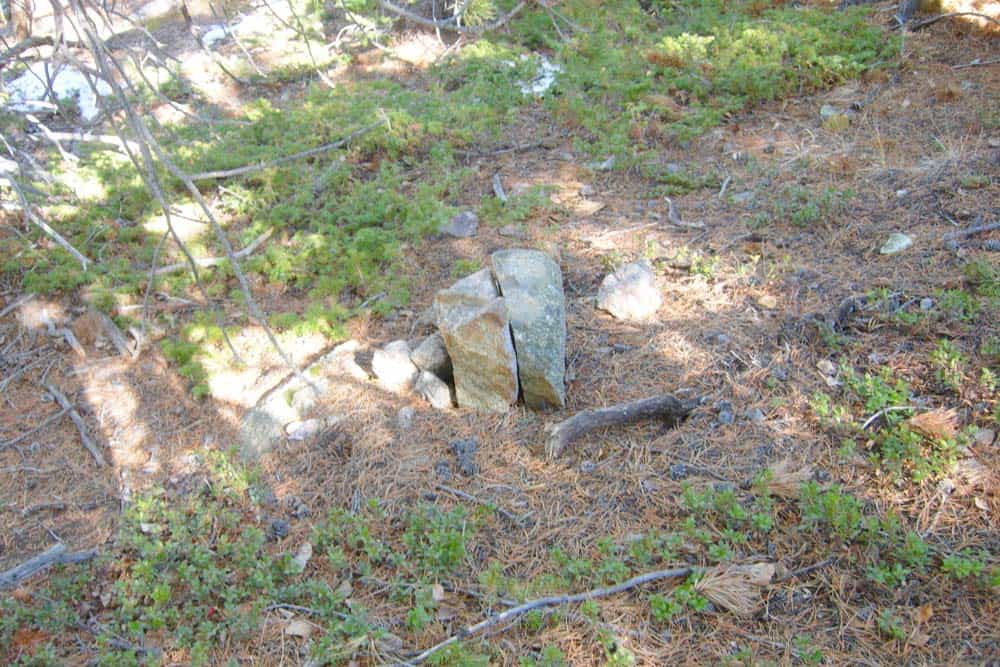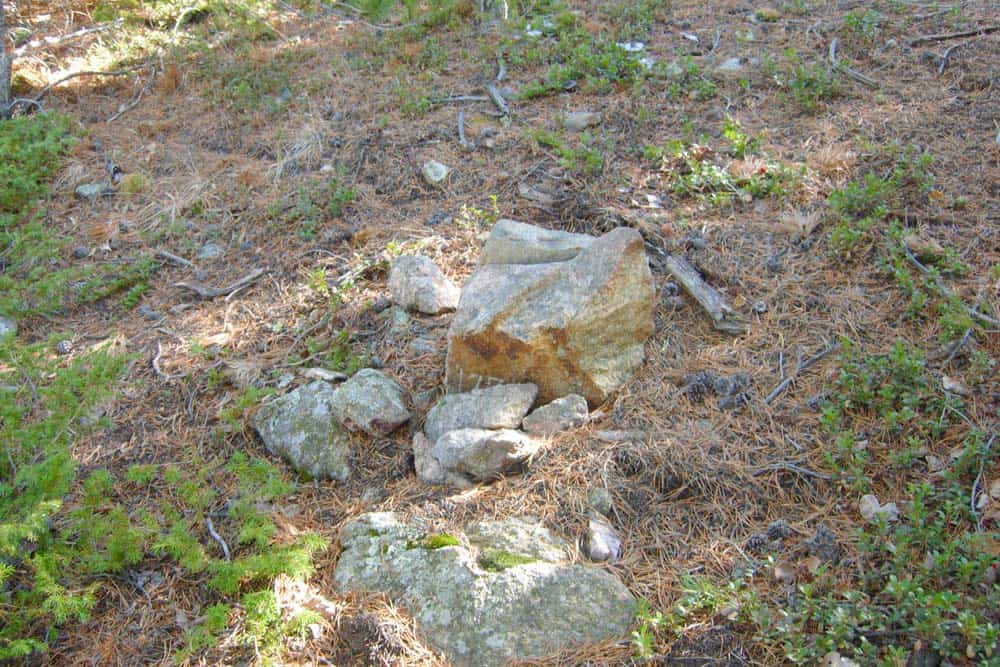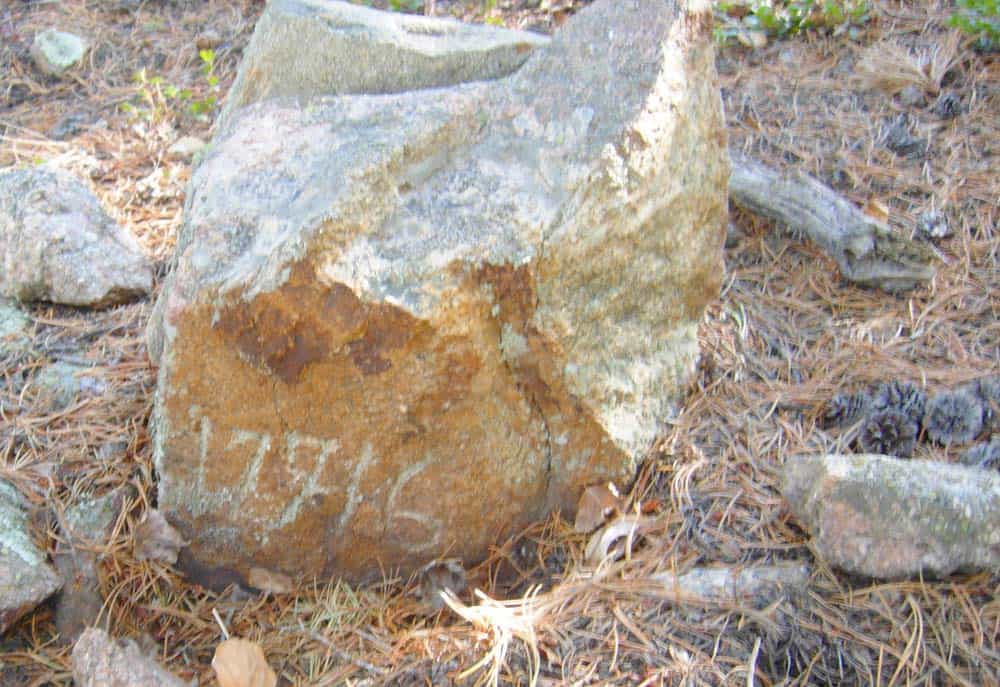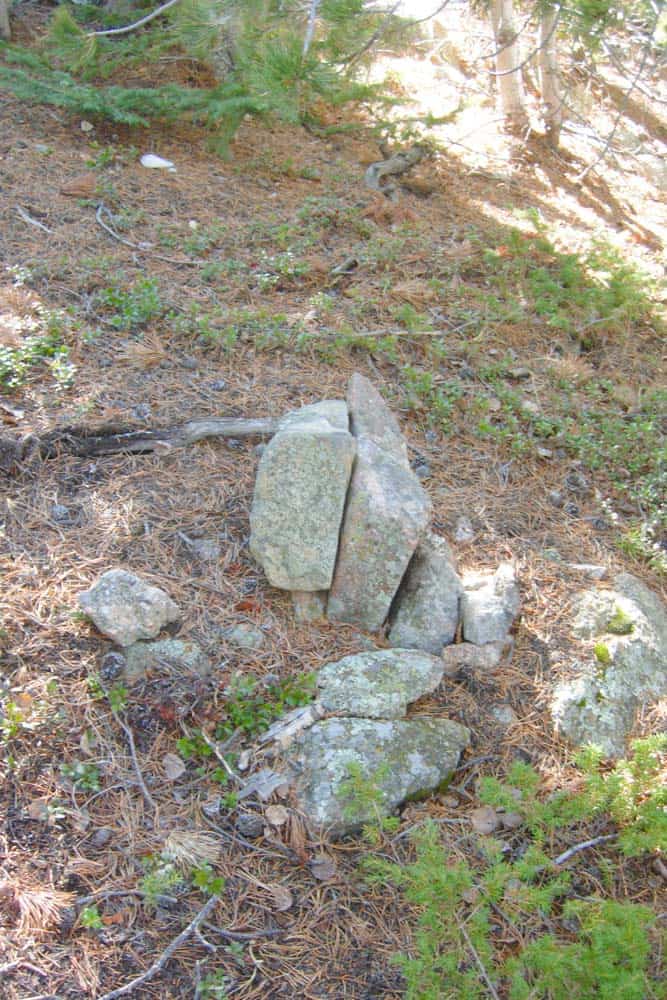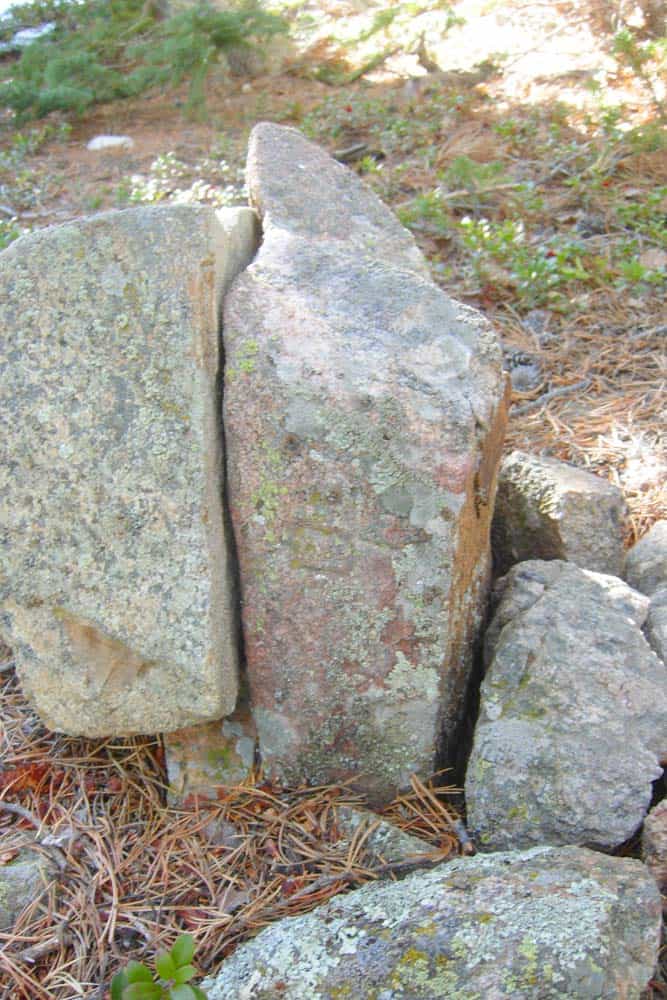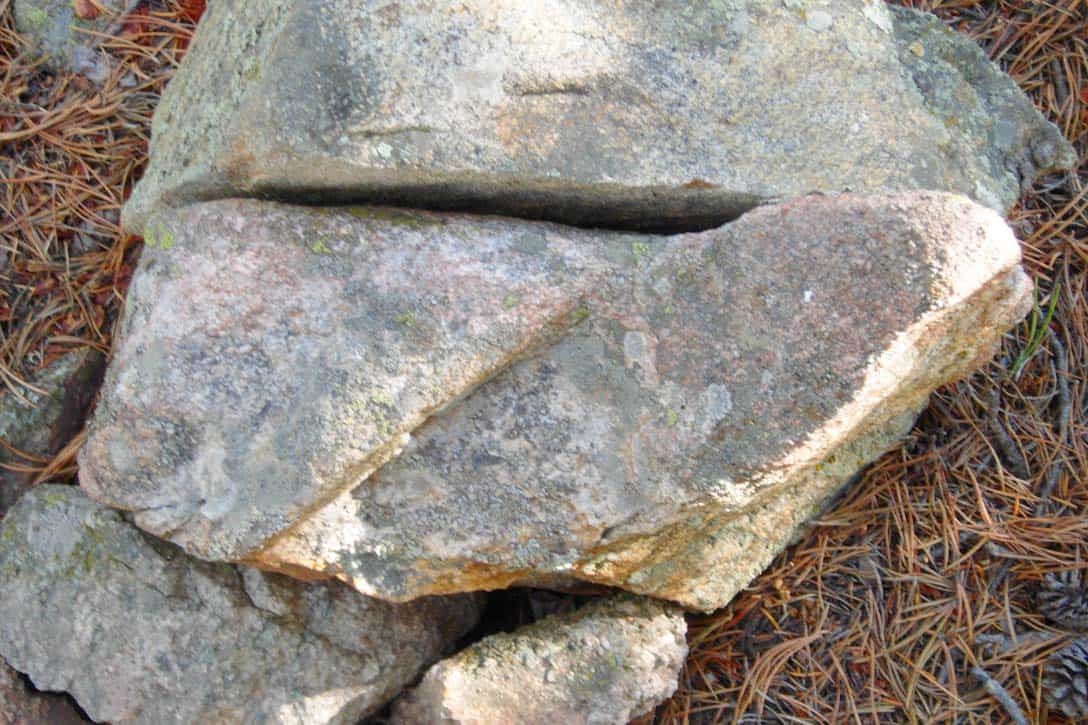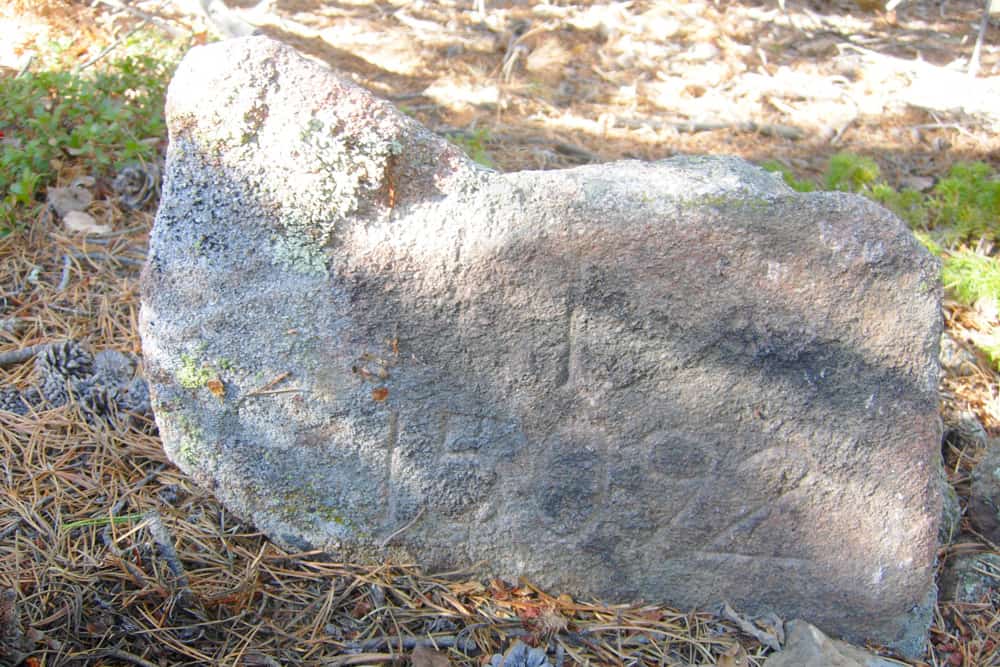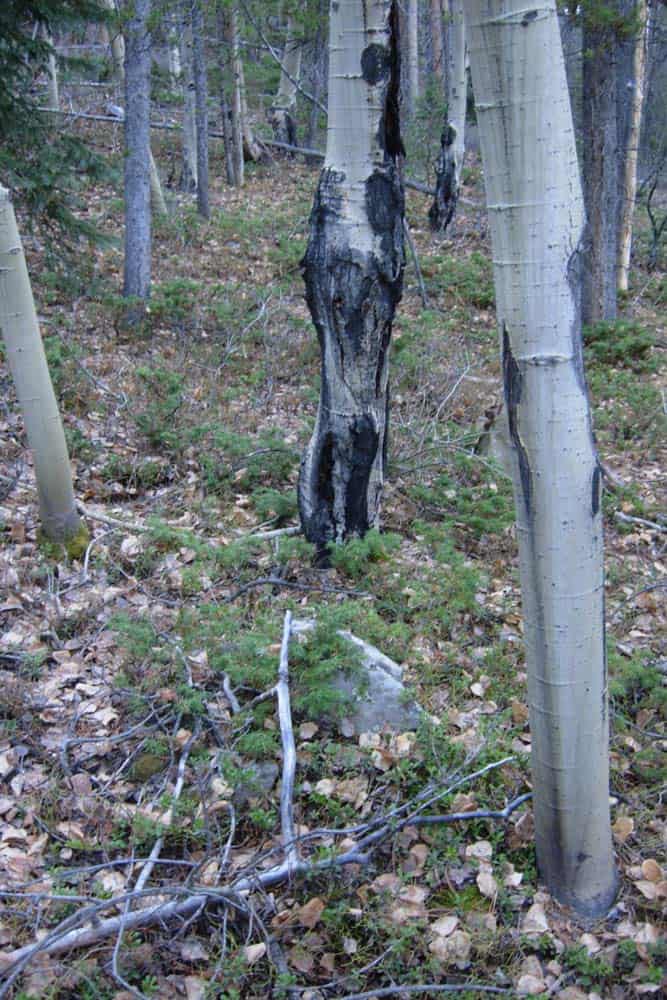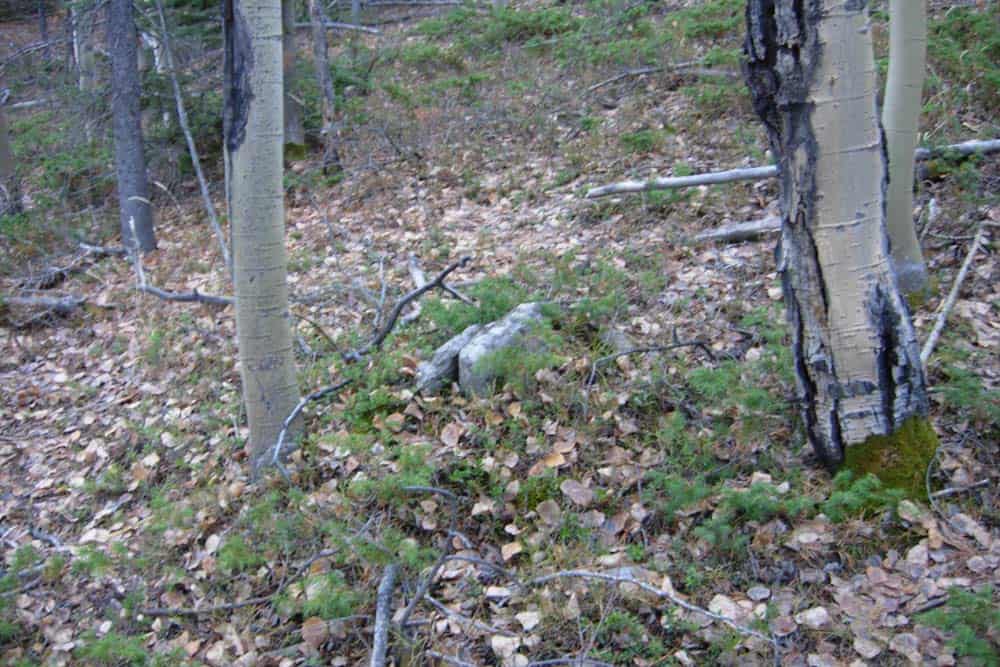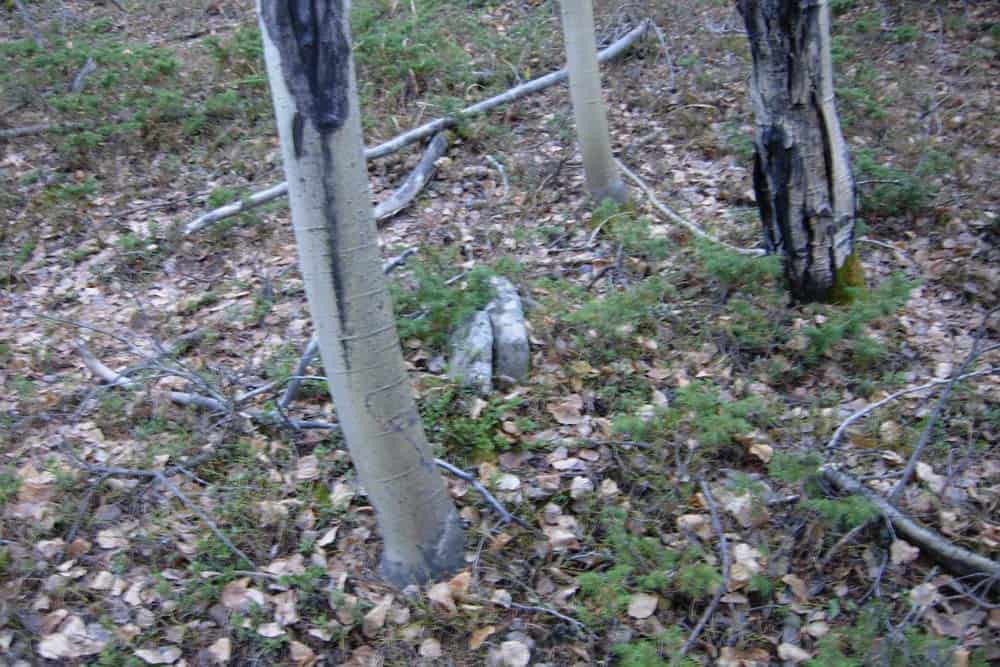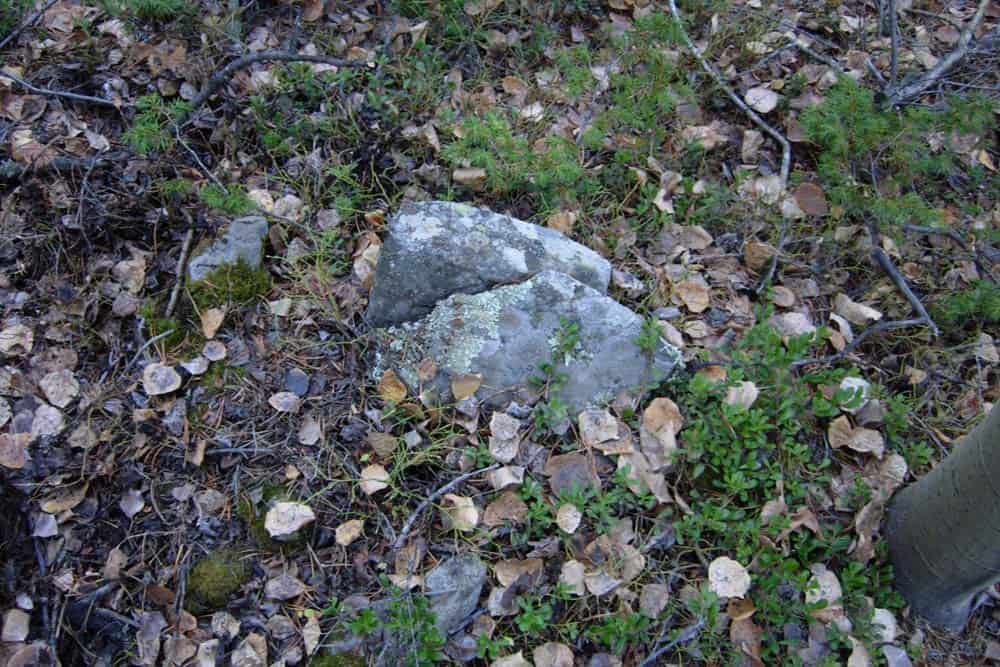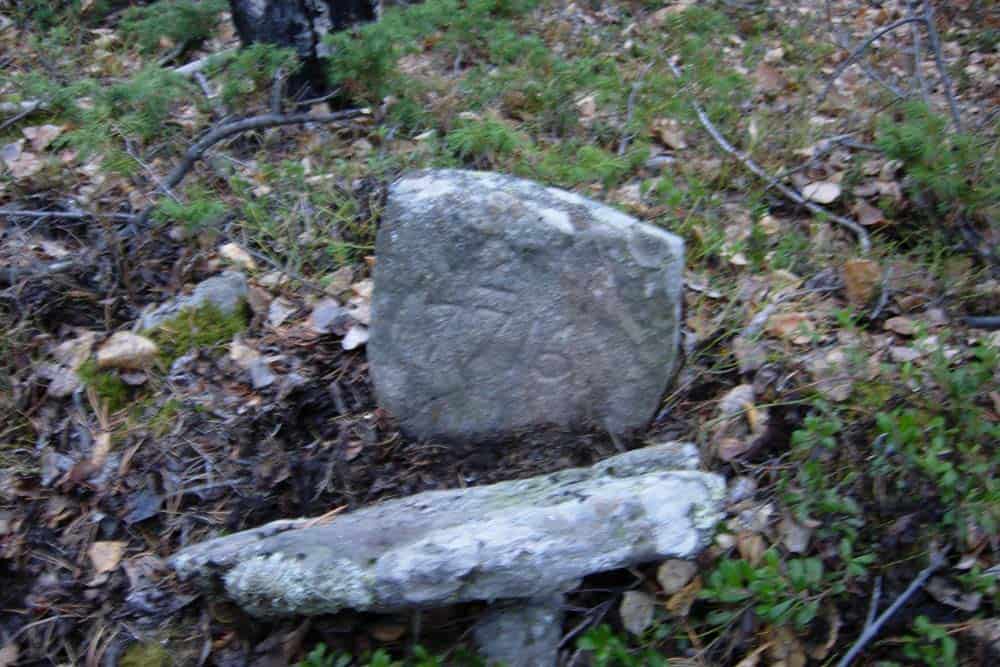This October, I found a stone corner that is common to two lode mining claims. Looking down at the stone monument, the stone appears to be cleaved into two halves. For those that are interested, the stone is a biotite-rich granitic gneiss.
The northerly stone half is firmly embedded into the ground, the other half rests on the ground surface. When you roll the loose half out of the way, the exposed face of the embedded stone has chiseled numbers that appear to be recently chiseled. Since the two halves fit together so tightly, no lichen grew on the southerly face. I have never seen that preservation trick used by a U.S. Dep. Mineral Surveyor before. I am curious if anyone else has found something similar.
The 10 photos below show the stone set to mark Cor. No. 1 of the Little Johnie No. 2 Lode (MS 15092) and Cor. No. 4 of the Little Johnnie No. 3 Lode (MS 17716). Both surveys were done by A.J. Ventress, a U.S. Deputy Mineral Survey in Idaho Sprngs, CO. The surveys were conducted in 1903 and 1905.
Photo of the west face of the monument
North face (chiseled 17716)
Close-up of north face
East face
With close-ups showing the fit between the stones (see a lazy "4" chiseled on the right stone that represents the corner number of MS 17716)
Top of the stone
and finally the protected south face (chiseled 1/15092)
Protective stone with what looks like some faint chiseling....NOT
Protective stone moved to reveal the freshly chiseled south face
Close-up of south face
Gene Kooper, post: 350260, member: 9850 wrote: This October, I found a stone corner that is common to two lode mining claims. Looking down at the stone monument, the stone appears to be cleaved into two halves. For those that are interested, the stone is a biotite-rich granitic gneiss.
The northerly stone half is firmly embedded into the ground, the other half rests on the ground surface. When you roll the loose half out of the way, the exposed face of the embedded stone has chiseled numbers that appear to be recently chiseled. Since the two halves fit together so tightly, no lichen grew on the southerly face. I have never seen that preservation trick used by a U.S. Dep. Mineral Surveyor before. I am curious if anyone else has found something similar.
The 10 photos below show the stone set to mark Cor. No. 1 of the Little Johnie No. 2 Lode (MS 15092) and Cor. No. 4 of the Little Johnnie No. 3 Lode (MS 17716). Both surveys were done by A.J. Ventress, a U.S. Deputy Mineral Survey in Idaho Sprngs, CO. The surveys were conducted in 1903 and 1905.
Photo of the west face of the monument
North face (chiseled 17716)
Close-up of north face
East face
With close-ups showing the fit between the stones (see a lazy "4" chiseled on the right stone that represents the corner number of MS 17716)
Top of the stone
and finally the protected south face (chiseled 1/15092)
Protective stone with what looks like some faint chiseling....NOT
Protective stone moved to reveal the freshly chiseled south face
Close-up of south face
Very cool, can't get enough of survey stone pictures!!
Gene Kooper, post: 350260, member: 9850 wrote: This October, I found a stone corner that is common to two lode mining claims. Looking down at the stone monument, the stone appears to be cleaved into two halves. For those that are interested, the stone is a biotite-rich granitic gneiss.
The northerly stone half is firmly embedded into the ground, the other half rests on the ground surface. When you roll the loose half out of the way, the exposed face of the embedded stone has chiseled numbers that appear to be recently chiseled. Since the two halves fit together so tightly, no lichen grew on the southerly face. I have never seen that preservation trick used by a U.S. Dep. Mineral Surveyor before. I am curious if anyone else has found something similar.
The 10 photos below show the stone set to mark Cor. No. 1 of the Little Johnie No. 2 Lode (MS 15092) and Cor. No. 4 of the Little Johnnie No. 3 Lode (MS 17716). Both surveys were done by A.J. Ventress, a U.S. Deputy Mineral Survey in Idaho Sprngs, CO. The surveys were conducted in 1903 and 1905.
Photo of the west face of the monument
North face (chiseled 17716)
Close-up of north face
East face
With close-ups showing the fit between the stones (see a lazy "4" chiseled on the right stone that represents the corner number of MS 17716)
Top of the stone
and finally the protected south face (chiseled 1/15092)
Protective stone with what looks like some faint chiseling....NOT
Protective stone moved to reveal the freshly chiseled south face
Close-up of south face
SWEET!
No matter how long you stumble around old surveys, there's always something new to bump into.
Good work Gene!
Loyal
Gene Kooper, post: 350260, member: 9850 wrote: This October, I found a stone corner that is common to two lode mining claims. Looking down at the stone monument, the stone appears to be cleaved into two halves. For those that are interested, the stone is a biotite-rich granitic gneiss.
The northerly stone half is firmly embedded into the ground, the other half rests on the ground surface. When you roll the loose half out of the way, the exposed face of the embedded stone has chiseled numbers that appear to be recently chiseled. Since the two halves fit together so tightly, no lichen grew on the southerly face. I have never seen that preservation trick used by a U.S. Dep. Mineral Surveyor before. I am curious if anyone else has found something similar.
The 10 photos below show the stone set to mark Cor. No. 1 of the Little Johnie No. 2 Lode (MS 15092) and Cor. No. 4 of the Little Johnnie No. 3 Lode (MS 17716). Both surveys were done by A.J. Ventress, a U.S. Deputy Mineral Survey in Idaho Sprngs, CO. The surveys were conducted in 1903 and 1905.
Photo of the west face of the monument
North face (chiseled 17716)
Close-up of north face
East face
With close-ups showing the fit between the stones (see a lazy "4" chiseled on the right stone that represents the corner number of MS 17716)
Nice find Gene. I found a stone once with an ancient chiseled X, another surveyor was threatening to testify that he just chiseled it a few months before. How do you explain the difference, being a mineral expert? It was very worn and hollowed out with no sharp edges, hard stone (gneiss or granite) plus I worked for the guy for a few years and knew he never chiseled on stones.
Dave Karoly, post: 350267, member: 94 wrote: Jameson asks, "Where is the dimple? I don't see the dimple?"
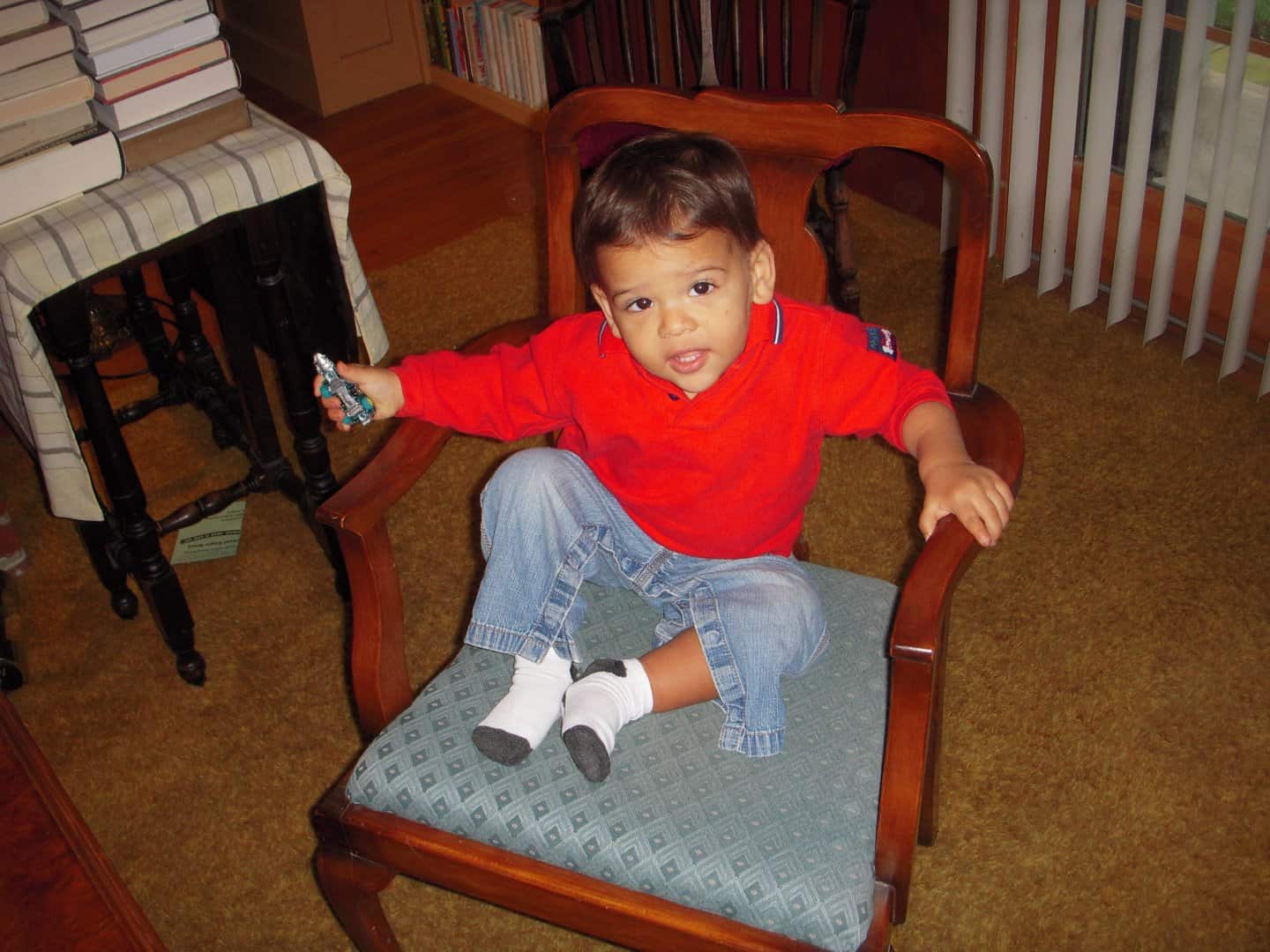
Dave,
Let Jameson know that the dimple is there, but obscured by lichen. If he wants to see it in person, his grandpa will need to take him on a road trip next May.
Dave Karoly, post: 350267, member: 94 wrote: Jameson asks, "Where is the dimple? I don't see the dimple?"

Dave,
Let Jameson know that the dimple is there, but obscured by lichen. If he wants to see it in person, his grandpa will need to take him on a road trip next May.
General assistance por favor: How does one post a response directly under a reply instead of it going to the bottom of the thread?
Duane Frymire, post: 350280, member: 110 wrote: Nice find Gene. I found a stone once with an ancient chiseled X, another surveyor was threatening to testify that he just chiseled it a few months before. How do you explain the difference, being a mineral expert? It was very worn and hollowed out with no sharp edges, hard stone (gneiss or granite) plus I worked for the guy for a few years and knew he never chiseled on stones.
Duane,
My suggestion would be to find a nearby rock or two that are the same rock type as your stone with ancient chiseled X. Get out your stone chisel and whack away on them. Then get out your hand lens and compare the new marks with the ancient one. You may find an oxidized layer on the ancient stone.
If the rock type is something like a granite, you can also look closely at the individual mineral grains. Sharp, well-defined crystal faces and edges may indicate the mark was recently made.
If your survey buddy used a nail, plumb bob tip (do surveyors still use plumb bobs) or other sharp implement to "freshen" the X a few months before, my suggestions are useless.
Gene Kooper, post: 350283, member: 9850 wrote: Dave,
Let Jameson know that the dimple is there, but obscured by lichen. If he wants to see it in person, his grandpa will need to take him on a road trip next May.General assistance por favor: How does one post a response directly under a reply instead of it going to the bottom of the thread?
Problem "In Review" as a result of thread "Reply versus Comment" attempt to document related problems.
Dallas Morlan, post: 350288, member: 6020 wrote: Problem "In Review" as a result of thread "Reply versus Comment" attempt to document related problems.
Thanks, I think. And here I thought I was the only one that has a lot of idle time lately. :whistle:
Gene Kooper, post: 350294, member: 9850 wrote: Thanks, I think. And here I thought I was the only one that has a lot of idle time lately. :whistle:
Except that I think the solution was to not have the "comment" option available, since it was causing such consternation ...
Warren Smith, post: 350295, member: 9900 wrote: Except that I think the solution was to not have the "comment" option available, since it was causing such consternation ...
Egad.
Warren Smith, post: 350295, member: 9900 wrote: Except that I think the solution was to not have the "comment" option available, since it was causing such consternation ...
Warren, I keep clicking on the [insert pithy saying here] under your posts, but I can't insert any of my pithy sayings. I think this feature is broken. Can we get someone on that right away? 😛
skwyd, post: 350316, member: 6874 wrote: Warren, I keep clicking on the [insert pithy saying here] under your posts, but I can't insert any of my pithy sayings. I think this feature is broken. Can we get someone on that right away? 😛
Hah! That is my lazy way of not having to come up with one on my own.
Good find Gene!
We need more Gene! We need more Gene! We need more Gene!
Well, since Holy Cow asked for more.... However, I must resist posting photos of all the stone corners I found on this project. Also, too, Wendell would likely shoot me if I posted 750 MB of JPEG files.
My client owns three lode claims and three gores between the mineral surveys. Thirty seven corners define his boundary. All are stones. I found 34 corners. The most troubling of the 3 missing monuments is one that I thought would be the easiest to find. That corner is located in the trees and away from any mining activity. The corner was set by U.S. Dep. Mineral Survey, James Underhill. He is the author of the only book written on mineral land surveying. He also obtained a PhD in geology from the Univ. of Colorado and was a professor at my alma mater. His work should be a piece of cake to retrace, right? His field notes describe the corner as an "X" chiseled on a 6'x3'x3' boulder. The spot where that nice, huge boulder is supposed to reside is barren of ANY rock or stone! I have some 'splainin to do on my plat as to why I set a 30" long aluminum pipe with cap in a spot that should be occupied by a substantial boulder with an ancient "X" carved deeply into it.
Here are photos of a second protected stone, Cor. No. 2 of the Little Johnnie No. 3 Lode (MS 17716). This corner is 1600 feet to the northeast and 900 feet below the stone corner that started this thread.
When I found the first protected stone, I was unsure if it was done by the mineral survey or claim owner. Finding the second protected stone indicates that the mineral surveyor was more likely responsible. The photos below were taken during my reconnaissance of the area in low light conditions.
A split rock among the aspens
North face with cover stone as found
North face with cover stone laid flat
Close-up view of north face. No need to clean up this stone to read the chiseled numbers!
Earthquake?
Or maybe it was 6" x 3" x 3".
